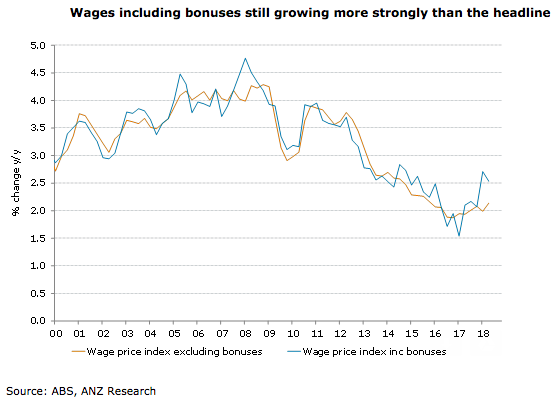Australia’s wage price growth for the second quarter of this year edged higher but still only very gradually, with annual wage growth ticking up to 2.1 percent, following a downwardly revised 2.0 percent in the first quarter. Growth in the WPI including bonuses is still higher than the headline measure, though it did slow a touch.
The wage price index (WPI) rose by 0.6 percent q/q and 2.1 percent y/y in Q2, in line with expectations. Growth in public wages (0.6 percent q/q) continued to outstrip private wages (0.5 percent q/q), although the gap is gradually closing.
Growth in the measure of wages including bonuses edged down to 2.5 percent y/y from 2.7 percent y/y, although it remains significantly stronger than the headline. This continues to suggest that firms are paying bonuses to attract staff, but at the same time retaining flexibility around costs.
"Looking ahead, we expect to see a further gradual improvement in wage growth in 2018 and 2019. There should be further upside in Q3, when some large enterprise bargaining agreements and the higher-than-usual minimum wage rise of 3.5 percent come into effect. More broadly though, labour market spare capacity is gradually declining, evidenced in the high proportion of firms reporting difficulty finding suitable labour," according to the latest report from ANZ Research.
Meanwhile, from the RBA’s perspective, the ongoing gradual improvement in wages growth is consistent with its view that the laws of supply and demand are working. But a more meaningful acceleration in wages growth will be required before inflation looks to be convincingly heading towards the mid-point of the target band.



 Yen Near Lows as Markets Await Bank of Japan Rate Decision, Euro Slips After ECB Signals Caution
Yen Near Lows as Markets Await Bank of Japan Rate Decision, Euro Slips After ECB Signals Caution  Gold Prices Fall Amid Rate Jitters; Copper Steady as China Stimulus Eyed
Gold Prices Fall Amid Rate Jitters; Copper Steady as China Stimulus Eyed  RBA Unlikely to Cut Interest Rates in 2026 as Inflation Pressures Persist, Says Westpac
RBA Unlikely to Cut Interest Rates in 2026 as Inflation Pressures Persist, Says Westpac  South Korea Warns Weak Won Could Push Inflation Higher in 2025
South Korea Warns Weak Won Could Push Inflation Higher in 2025  BoE Set to Cut Rates as UK Inflation Slows, but Further Easing Likely Limited
BoE Set to Cut Rates as UK Inflation Slows, but Further Easing Likely Limited  Oil Prices Climb on Venezuela Blockade, Russia Sanctions Fears, and Supply Risks
Oil Prices Climb on Venezuela Blockade, Russia Sanctions Fears, and Supply Risks  Gold and Silver Surge as Safe Haven Demand Rises on U.S. Economic Uncertainty
Gold and Silver Surge as Safe Haven Demand Rises on U.S. Economic Uncertainty 




























